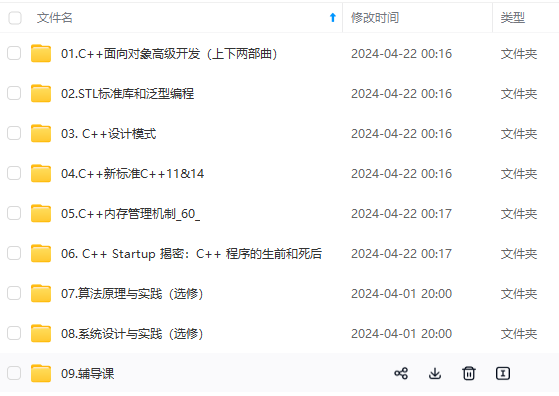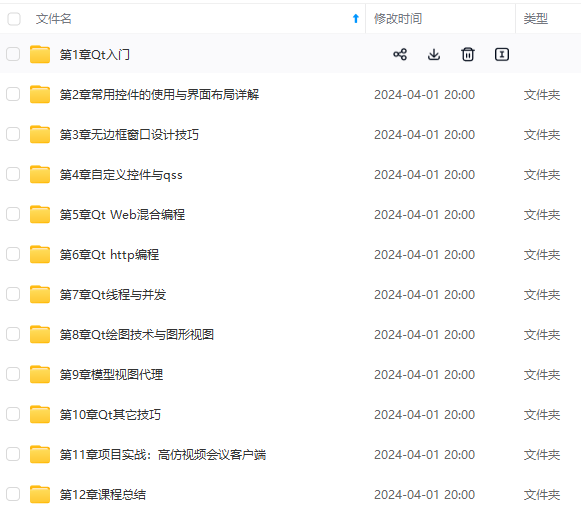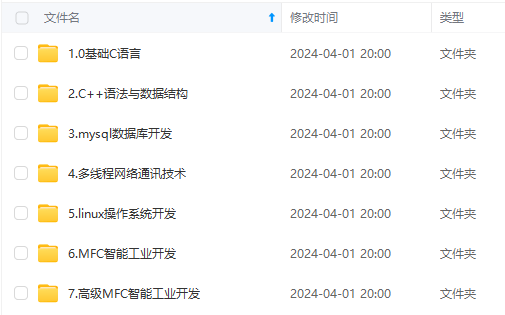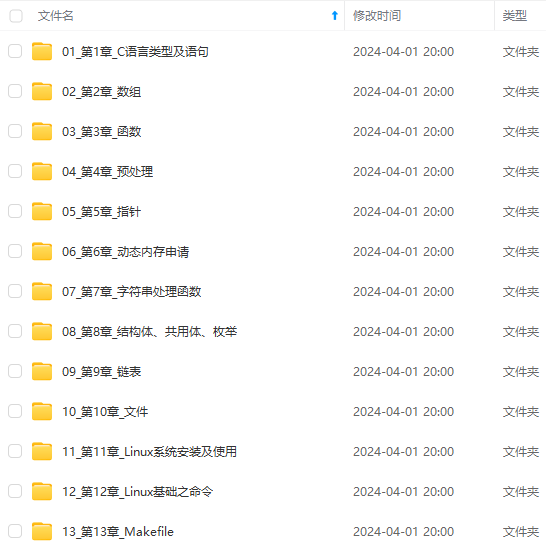

网上学习资料一大堆,但如果学到的知识不成体系,遇到问题时只是浅尝辄止,不再深入研究,那么很难做到真正的技术提升。
一个人可以走的很快,但一群人才能走的更远!不论你是正从事IT行业的老鸟或是对IT行业感兴趣的新人,都欢迎加入我们的的圈子(技术交流、学习资源、职场吐槽、大厂内推、面试辅导),让我们一起学习成长!
cin >> a >> b;
if (b == 0)
throw invalid_argument("除0错误");
return a / b;
}
void Func()
{
SmartPtr sp1(new int);
SmartPtr sp2(new int);
cout << div() << endl;
}
int main()
{
try
{
Func();
}
catch (const exception& e)
{
cout << e.what() << endl;
}
return 0;
}
### 2.智能指针的原理
上述的SmartPtr还不能将其称为智能指针,因为它还不具有指针的行为。指针可以解引用,也可以通过->去访问所指空间中的内容,因此:AutoPtr模板类中还得需要将\* 、->重载下,才可让其像指针一样去使用。
template
class SmartPtr
{
public:
SmartPtr(T* ptr = nullptr)
: _ptr(ptr)
{}
~SmartPtr()
{
if (_ptr)
delete _ptr;
}
T& operator*() { return _ptr; }
T operator->() { return _ptr; }
private:
T* _ptr;
};
总结一下智能指针的原理:
>
> **1.具有RAll特性
> 2.重载operator\*和operator->,具有和指针一样的行为。**
>
>
>
---
## 三、智能指针的分类
### 1.std::auto\_ptr
C++98版本的库中就提供了auto\_ptr的智能指针。
下面演示的auto\_ptr的使用及问题。其原理是:管理权转移。
namespace GoodQ
{
template
class auto_ptr
{
public:
auto_ptr(T* ptr)
:_ptr(ptr)
{}
auto_ptr(auto_ptr& sp)
:_ptr(sp._ptr)
{
// 管理权转移
sp._ptr = nullptr;
}
auto_ptr& operator=(auto_ptr& ap)
{
// 检测是否为自己给自己赋值
if (this != &ap)
{
// 释放当前对象中资源
if (_ptr)
delete _ptr;
// 转移ap中资源到当前对象中
_ptr = ap._ptr;
ap._ptr = NULL;
}
return this;
}
~auto_ptr()
{
if (_ptr)
{
cout << “delete:” << _ptr << endl;
delete _ptr;
}
}
// 像指针一样使用
T& operator()
{
return _ptr;
}
T operator->()
{
return _ptr;
}
private:
T* _ptr;
};
}
int main()
{
std::auto_ptr sp1(new int);
std::auto_ptr sp2(sp1); // 管理权转移
// sp1悬空
*sp2 = 10;
cout << *sp2 << endl;
cout << *sp1 << endl;
return 0;
}
结论:auto\_ptr是一个失败设计,很多公司明确要求不能使用auto\_ptr
### 2.std::unique\_ptr
C++11中开始提供更靠谱的unique\_ptr.其原理是:防止拷贝。
namespace GoodQ
{
template
class unique_ptr
{
public:
unique_ptr(T* ptr)
:_ptr(ptr)
{}
~unique_ptr()
{
if (_ptr)
{
cout << “delete:” << _ptr << endl;
delete _ptr;
}
}
// 像指针一样使用
T& operator*()
{
return _ptr;
}
T operator->()
{
return _ptr;
}
unique_ptr(const unique_ptr& sp) = delete;
unique_ptr& operator=(const unique_ptr& sp) = delete;
private:
T* _ptr;
};
}
int main()
{
std::unique_ptr sp1(new int);
return 0;
}
### 3.std::shard\_ptr
C++11中开始提供更靠谱的并且支持拷贝的shared\_ptr。
shared\_ptr的原理:是通过引用计数的方式来实现多个shared\_ptr对象之间共享资源
>
> **1.shared\_ptr在其内部,给每个资源都维护了着一份计数,用来记录该份资源被几个对象共享。
> 2.在对象被销毁时(也就是析构函数调用),就说明自己不使用该资源了,对象的引用计数减1。
> 3.如果引用计数是0,就说明自己是最后一个使用该资源的对象,必须释放该资源;
> 4.如果不是0,就说明除了自己还有其他对象在使用该份资源,不能释放该资源,否则其他对象就成野指针了。**
>
>
>
template
class shared_ptr
{
public:
shared_ptr(T* ptr = nullptr)
:_ptr(ptr)
, _pcount(new int(1))
{}
template
shared_ptr(T* ptr, D del)
: _ptr(ptr)
, _pcount(new int(1))
, _del(del)
{}
void release()
{
if (–(*_pcount) == 0)
{
_del(_ptr);
delete _pcount;
}
}
~shared_ptr()
{
release();
}
shared_ptr(const shared_ptr<T>& sp)
:_ptr(sp._ptr)
, _pcount(sp._pcount)
{
++(*_pcount);
}
// sp1 = sp3
shared_ptr<T>& operator=(const shared_ptr<T>& sp)
{
if (_ptr != sp._ptr)
{
release();
_ptr = sp._ptr;
_pcount = sp._pcount;
++(*_pcount);
}
return *this;
}
// 像指针一样
T& operator*()
{
return *_ptr;
}
T* operator->()
{
return _ptr;
}
int use_count() const
{
return *_pcount;
}
T* get() const
{
return _ptr;
}
private:
T* _ptr;
int* _pcount;
function<void(T*)> _del = [](T* ptr) {delete ptr; };
};
std::shared\_ptr的循环引用问题
struct ListNode
{
int _data;
shared_ptr _prev;
shared_ptr _next;
~ListNode() { cout << “~ListNode()” << endl; }
};
int main()
{
shared_ptr node1(new ListNode);
shared_ptr node2(new ListNode);
cout << node1.use_count() << endl;
cout << node2.use_count() << endl;
node1->_next = node2;
node2->_prev = node1;
cout << node1.use_count() << endl;
cout << node2.use_count() << endl;
return 0;
}
循环引用分析:


**既有适合小白学习的零基础资料,也有适合3年以上经验的小伙伴深入学习提升的进阶课程,涵盖了95%以上C C++开发知识点,真正体系化!**
**由于文件比较多,这里只是将部分目录截图出来,全套包含大厂面经、学习笔记、源码讲义、实战项目、大纲路线、讲解视频,并且后续会持续更新**
**[如果你需要这些资料,可以戳这里获取](https://bbs.csdn.net/topics/618668825)**
l;
return 0;
}
循环引用分析:
[外链图片转存中…(img-mQKyioUA-1715752243392)]
[外链图片转存中…(img-9JVquZFo-1715752243393)]
既有适合小白学习的零基础资料,也有适合3年以上经验的小伙伴深入学习提升的进阶课程,涵盖了95%以上C C++开发知识点,真正体系化!
由于文件比较多,这里只是将部分目录截图出来,全套包含大厂面经、学习笔记、源码讲义、实战项目、大纲路线、讲解视频,并且后续会持续更新





















 572
572











 被折叠的 条评论
为什么被折叠?
被折叠的 条评论
为什么被折叠?








